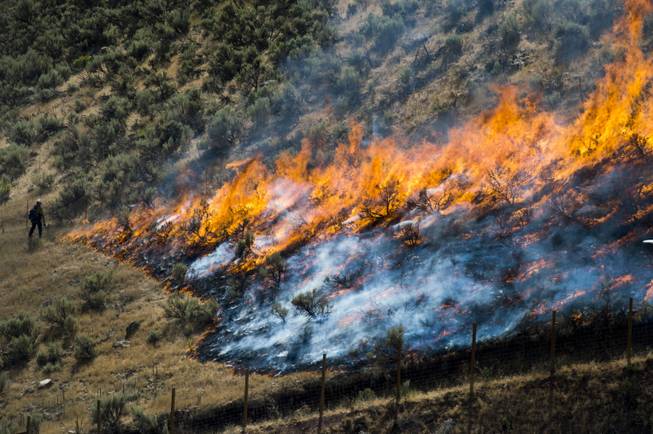
Rick Egan/The Salt Lake Tribune via AP, File
In this July 30, 2018, file photo, firefighters control the Tollgate Canyon fire as it burns near Wanship, Utah. The Trump administration is proposing an ambitious plan to slow Western wildfires by bulldozing, mowing or revegetating large swaths of land along 11,000 miles of terrain in the West. The plan announced this summer would create strips of land known as “fuel breaks” in parts of Idaho, Oregon, Washington, California, Nevada and Utah.
Tuesday, July 23, 2019 | 2 a.m.
An official with a leading conservation group is highly critical of a federal plan to control the spread of wildfires across a swath of the American West through the use of thousands of miles of man-made firebreaks.
The federal Bureau of Land Management’s plan would create up to 11,000 miles of fuel breaks — tracts of land either where all plants have been removed, or where the flora on-site is replaced with less flammable alternatives — across the Great Basin.
Patrick Donnelly, state director for the Center for Biological Diversity, calls the idea a “boondoggle” and a potential disaster for the sagebrush ecosystem.
“This is classic habitat fragmentation where you’re creating dead zones where animals, wildlife and plants won’t be,” Donnelly said.
The project would cover a massive area — 223 million acres across six states, including Nevada.
There are multiple ways fuel breaks can be established including through the use of equipment like large mowers, controlled burns or targeted cattle grazing — essentially employing cattle to keep down plant growth.
Donnelly is especially skeptical of the grazing plan, calling it “ludicrous.”
“It certainly isn’t deployable at a scale where you could do 11,000 miles,” he said.
There are multiple ways to define the Great Basin, an area that stretches across six Western states where sources of water are self-contained, or do not drain into any ocean. Most of Nevada is within the Great Basin.
Jennifer Jones, a spokesperson for the BLM, said the number of fires in the Great Basin was on the rise.
“Historically, wildfires burned in this ecosystem every 30 to 200 years,” she said in an email. “Now, some areas in the Great Basin burn approximately every five to seven years.”
Some of those fires were larger than others. According to the BLM’s environmental impact statement, 21 fires between 2009 and 2018 burned over 100,000 acres each in the Great Basin. Wildfire suppression efforts have cost the BLM approximately $373 million in the same time period.
One of those wildfires was the Martin Fire, which began July 4, 2018, and continued to burn for 30 days in north-central Nevada, eventually becoming the largest wildfire in state history. An estimated 435,000 acres (680 square miles) of grass and brush burned, decimating ranches and the area’s ecosystem.
“These wildfires result in increased destruction of private property, degradation and loss of rangelands, loss of recreational opportunities and habitat loss for a variety of species, including the conversion of native habitats to invasive annual grasses,” the BLM said in the statement.
The increase in wildfires in the Great Basin is partly attributed to the introduction of invasive plant species. One of the biggest fire dangers is cheatgrass, an annual plant native to Eurasia that dies just in time for the West’s wildfire season.
Donnelly suggests that instead of investing in the massive fuel break program, the BLM should focus on replanting native flora.
Brian Beffort, director of the Toiyabe chapter of the Sierra Club, said he was concerned that fuel breaks would act as other disturbances such as power lines have and create an environment in which cheatgrass could spread.
“We have a lot of concerns and a lot of questions,” he said.
Donnelly said there has been a lot of debate around the role of fire in the Great Basin ecosystem. Restoring the natural role fire has in the region’s environment would take a massive investment, he added.
“The biggest jobs program the Great Basin’s ever seen — that’s what we ought to be doing when we want to address fire,” said Donnelly, whose office is in Las Vegas.
Jones said the BLM had conducted 1,200 assessments of wildfire fuel control since 2002. Eighty-percent of those assessments were found to help with wildfire control and 85% were found to have helped change fire behavior, she said.
The fuel breaks would not be placed haphazardly. According to the BLM, they would be set near places like roads, pipelines and power lines, to minimize the amount of ground disturbed and lessen impacts on the environment.
“To mitigate the potential for those impacts, one thing to consider and remember is the fuel breaks are not new disturbances,” said Marlo Draper, project manager for the BLM’s Idaho-Great Basin Support Team, who added that expectations for fuel breaks should be realistic.
“We do not expect fuel breaks to stop fires,” she said. Instead, she said, the breaks could slow fires and reduce their intensity, letting firefighters come in safely.
The BLM completed three public meetings on the plan earlier this month in Northern Nevada, but Draper encouraged anyone wishing to comment on the firebreaks to do so via the agency’s website, blm.gov. The BLM will continue to receive public comments until midnight Aug. 5.
“There’s lot of opportunity for the public to learn more about it and comment on it,” she said.
